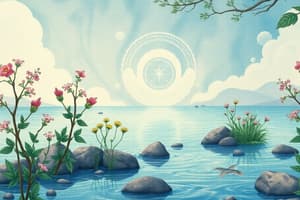Podcast
Questions and Answers
التلوث يعد من المشاكل البسيطة التي يواجهها الإنسان المعاصر.
التلوث يعد من المشاكل البسيطة التي يواجهها الإنسان المعاصر.
False (B)
إجراءات معالجة التلوث تتطلب تظافر الجهود كافة.
إجراءات معالجة التلوث تتطلب تظافر الجهود كافة.
True (A)
للإنسان دور في زيادة خطورة التلوث من خلال نشاطاته.
للإنسان دور في زيادة خطورة التلوث من خلال نشاطاته.
True (A)
التلوث لا يهدد الحياة البشرية بشكل مباشر.
التلوث لا يهدد الحياة البشرية بشكل مباشر.
المشاكل الناتجة عن التلوث يمكن حلها دون الحاجة إلى التعاون بين الأفراد والمجتمعات.
المشاكل الناتجة عن التلوث يمكن حلها دون الحاجة إلى التعاون بين الأفراد والمجتمعات.
تشكل المياه الصالحة للشرب نحو % 0.01 من المياه العذبة.
تشكل المياه الصالحة للشرب نحو % 0.01 من المياه العذبة.
التزايد المضطرد في عدد السكان يؤدي إلى زيادة حصة الفرد من المياه الصالحة للشرب.
التزايد المضطرد في عدد السكان يؤدي إلى زيادة حصة الفرد من المياه الصالحة للشرب.
حماية المياه من التلوث أصبحت موضوعًا مهمًا بسبب انخفاض حصة المياه الصالحة للشرب.
حماية المياه من التلوث أصبحت موضوعًا مهمًا بسبب انخفاض حصة المياه الصالحة للشرب.
تعتبر المياه المستخدمة في الزراعة نسبة كبيرة من المياه الصالحة للشرب.
تعتبر المياه المستخدمة في الزراعة نسبة كبيرة من المياه الصالحة للشرب.
يجب أن يتم التعامل مع المياه كموارد محدودة في سياق التزايد السكاني.
يجب أن يتم التعامل مع المياه كموارد محدودة في سياق التزايد السكاني.
النسياب السطحي من الأراضي الزراعية يؤثر سلبًا على التنوع الأحيائي.
النسياب السطحي من الأراضي الزراعية يؤثر سلبًا على التنوع الأحيائي.
يمكن أن تكون مصادر المياه النقطية غير ملوثة.
يمكن أن تكون مصادر المياه النقطية غير ملوثة.
قيمة الـ BOD تشير إلى مستوى الأوكسجين المذاب في المياه.
قيمة الـ BOD تشير إلى مستوى الأوكسجين المذاب في المياه.
تأثير مياه النقطية يمكن أن يغير من قيم الأوكسجين المذاب في البيئات المائية.
تأثير مياه النقطية يمكن أن يغير من قيم الأوكسجين المذاب في البيئات المائية.
تقسيم نوعية المياه لا يعتمد على مصادر التلوث.
تقسيم نوعية المياه لا يعتمد على مصادر التلوث.
سمك التروبوبوز يبلغ عادة حوالي 20 كم من سطح البحر.
سمك التروبوبوز يبلغ عادة حوالي 20 كم من سطح البحر.
يختلف سمك التروبوبوز بدرجة كبيرة من مكان إلى آخر.
يختلف سمك التروبوبوز بدرجة كبيرة من مكان إلى آخر.
التروبوبوز هي الطبقة الأولى في الغلاف الجوي.
التروبوبوز هي الطبقة الأولى في الغلاف الجوي.
التروبوبوز تحتوي على بخار الماء بشكل كثيف.
التروبوبوز تحتوي على بخار الماء بشكل كثيف.
التروبوبوز تعرف باسم الطبقة الانتقالية في الغلاف الجوي.
التروبوبوز تعرف باسم الطبقة الانتقالية في الغلاف الجوي.
يتحول الفوسفور إلى نترات.
يتحول الفوسفور إلى نترات.
عندما تكون كمية الأوكسجين المذاب كافية، يتحول الكاربون إلى ميثان.
عندما تكون كمية الأوكسجين المذاب كافية، يتحول الكاربون إلى ميثان.
النيتروجين يتحول إلى أمونيا في ظل ظروف معينة.
النيتروجين يتحول إلى أمونيا في ظل ظروف معينة.
الكبريت يتحول إلى كبريتات عندما تكون كمية الأوكسجين المذاب كافية.
الكبريت يتحول إلى كبريتات عندما تكون كمية الأوكسجين المذاب كافية.
النيتروجين لا يتحول إلى أمينات ذات رائحة خاصة.
النيتروجين لا يتحول إلى أمينات ذات رائحة خاصة.
تصل المبيدات إلى جسم الإنسان بسهولة.
تصل المبيدات إلى جسم الإنسان بسهولة.
المبيدات لا تؤثر على الأحياء المفيدة غير المقصودة.
المبيدات لا تؤثر على الأحياء المفيدة غير المقصودة.
يمكن أن تكون المبيدات ضارة للحيوانات.
يمكن أن تكون المبيدات ضارة للحيوانات.
احتمالية إصابة المبيدات لبعض الأحياء المفيدة تعتبر مشكلة بسيطة.
احتمالية إصابة المبيدات لبعض الأحياء المفيدة تعتبر مشكلة بسيطة.
يعتبر استخدام المبيدات ممارسة آمنة تمامًا في الزراعة.
يعتبر استخدام المبيدات ممارسة آمنة تمامًا في الزراعة.
Flashcards
التلوث
التلوث
مشكلة تواجه البشر في العصر الحالي وتؤثر على حياتهم.
معالجة التلوث
معالجة التلوث
عملية تقليل أو إزالة التلوث.
تظافر الجهود
تظافر الجهود
العمل معًا لتحقيق هدف مشترك.
نشاطات بشرية
نشاطات بشرية
Signup and view all the flashcards
تهديد الحياة البشرية
تهديد الحياة البشرية
Signup and view all the flashcards
التروبوبوز
التروبوبوز
Signup and view all the flashcards
طبقة التروبوبوز و سمكها
طبقة التروبوبوز و سمكها
Signup and view all the flashcards
نطاق سمك طبقة التروبوبوز
نطاق سمك طبقة التروبوبوز
Signup and view all the flashcards
سمك طبقة التروبوبوز
سمك طبقة التروبوبوز
Signup and view all the flashcards
خصائص طبقة التروبوبوز
خصائص طبقة التروبوبوز
Signup and view all the flashcards
نسبة المياه الصالحة للشرب
نسبة المياه الصالحة للشرب
Signup and view all the flashcards
نمو السكان
نمو السكان
Signup and view all the flashcards
انخفاض حصة الفرد من المياه الصالحة للشرب
انخفاض حصة الفرد من المياه الصالحة للشرب
Signup and view all the flashcards
حماية المياه
حماية المياه
Signup and view all the flashcards
تلوث المياه
تلوث المياه
Signup and view all the flashcards
تحول الفوسفور في وجود الأكسجين
تحول الفوسفور في وجود الأكسجين
Signup and view all the flashcards
تحول الكبريت في وجود الأكسجين
تحول الكبريت في وجود الأكسجين
Signup and view all the flashcards
تحول النيتروجين في وجود الأكسجين
تحول النيتروجين في وجود الأكسجين
Signup and view all the flashcards
تحول الكربون في غياب الأكسجين الكافي
تحول الكربون في غياب الأكسجين الكافي
Signup and view all the flashcards
تحول النيتروجين في غياب الأكسجين الكافي
تحول النيتروجين في غياب الأكسجين الكافي
Signup and view all the flashcards
مصادر المياه النقطية الملوثة
مصادر المياه النقطية الملوثة
Signup and view all the flashcards
BOD
BOD
Signup and view all the flashcards
الأكسجين المذاب
الأكسجين المذاب
Signup and view all the flashcards
التنوع الأحيائي
التنوع الأحيائي
Signup and view all the flashcards
نوعية المياه
نوعية المياه
Signup and view all the flashcards
ما هو التلوث؟
ما هو التلوث؟
Signup and view all the flashcards
ما هي المبيدات؟
ما هي المبيدات؟
Signup and view all the flashcards
كيف تصل المبيدات إلى جسم الإنسان؟
كيف تصل المبيدات إلى جسم الإنسان؟
Signup and view all the flashcards
ما هو خطر المبيدات على الكائنات الحية؟
ما هو خطر المبيدات على الكائنات الحية؟
Signup and view all the flashcards
ما هي مخاطر المبيدات على الإنسان؟
ما هي مخاطر المبيدات على الإنسان؟
Signup and view all the flashcards
Study Notes
Environmental Pollution Study Notes
- Definition of Environmental Pollution: Environmental pollution is any change in the environment's characteristics that may directly or indirectly harm living creatures, infrastructure, or affect human life.
Levels of Environmental Pollution
-
Acceptable Pollution (Non-Hazardous): The initial level of pollution where the ecosystem's balance isn't affected, and no major environmental issues arise. No environment is completely pollution-free due to the transfer of contaminants via weather or human activities.
-
Hazardous Pollution: An advanced stage where the quantity and type of pollutants exceed the critical ecological limit, starting to negatively impact both natural elements and humans. Industrialized countries often face hazardous pollution, mainly due to industrial activity and reliance on fossil fuels.
-
Destructive Pollution: The stage where the ecological system collapses, unable to perform its natural functions due to drastic imbalance. Nuclear radiation is an example.
Types of Environmental Pollution
-
Air Pollution: The presence of harmful substances in the air, primarily affecting human health and the environment. Cigarette smoke is a significant example.
-
Water Pollution: Includes contamination of freshwater and marine environments.
-
Waste Pollution: Various waste types (domestic, industrial, hospital, agricultural) in solid, liquid, or gaseous forms, including radioactive waste.
-
Visual Pollution: Any visual impairment that causes discomfort upon sight, signifying a lack of aesthetic appreciation or a loss of visual beauty. Examples include buildings and roads.
-
Noise Pollution: Primarily associated with urban areas and technologically advanced regions, stemming from increased use of machinery and technology.
Classification by Nature
-
Chemical Composition: Includes organic pollutants (hydrocarbons) and inorganic pollutants (sulfur oxides).
-
Natural State: Gaseous, liquid, or solid pollutants.
-
Solvability: Ability to dissolve in water, oil, or fats.
-
Diffusion and Mitigation Rate: Speed of spreading and reduction.
-
Biodegradability: Capacity for biological breakdown.
-
Stability: Persistence in air, water, soil, and living organisms.
-
Reactivity: Potential to interact with other substances.
Classification by Source
-
Combustion Products: Residential, industrial, and agricultural emissions.
-
Industrial Products: Categorized by industry type, such as plastic, cement, or metal smelting.
-
Home and Service Products: Domestic waste, hospital waste, and laboratory waste.
-
Agricultural Products: Animal waste, fertilizer residue, and pesticide remains.
-
Military Activities: Environmental impacts from military actions.
-
Bacterial and Fungal Products: Acidic and basic substances.
Classification by Pattern of Use
-
Industrial Usage: Raw materials, solvents, dyes, stabilizers, and preservatives.
-
Residential and Hospital Usage: Cleaning agents, softeners, paints, disinfectants, and pesticides.
-
Agricultural Usage: Fertilizers, pesticides, and fuels.
-
Transportation Usage: Fuels, lubricants, and paints.
-
Military Usage
Classification by Effects
- Human Impact
- Animal Impact
- Plant Impact
- Atmospheric Component Impact (e.g., Ozone Layer)
- Aquatic Biological Process Impact
Classification of Pollutants
-
Natural: Pollutants not caused by human intervention, such as gases from volcanoes or solar flares.
-
Man-made: Pollutants introduced by humans through industrial processes, transportation, or everyday activities.
-
Chemical: Substances like pesticides, disinfectants, and petrochemicals.
-
Physical: Noise, radiation, and heat.
-
Biological: Microorganisms like bacteria, fungi, and viruses.
Studying That Suits You
Use AI to generate personalized quizzes and flashcards to suit your learning preferences.



